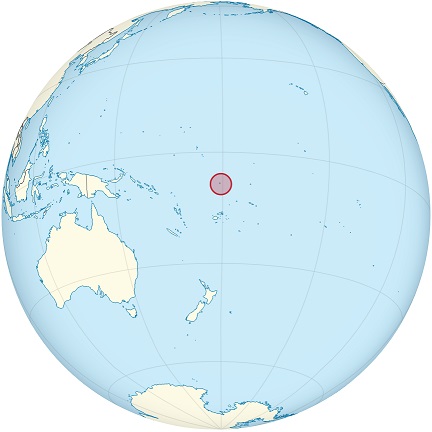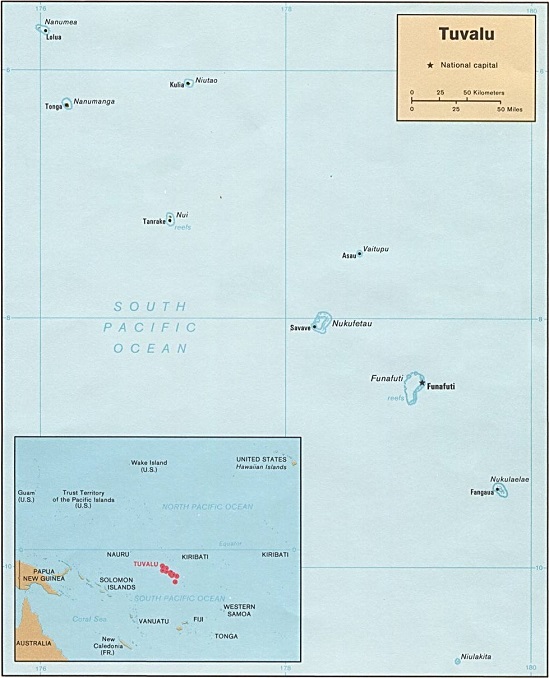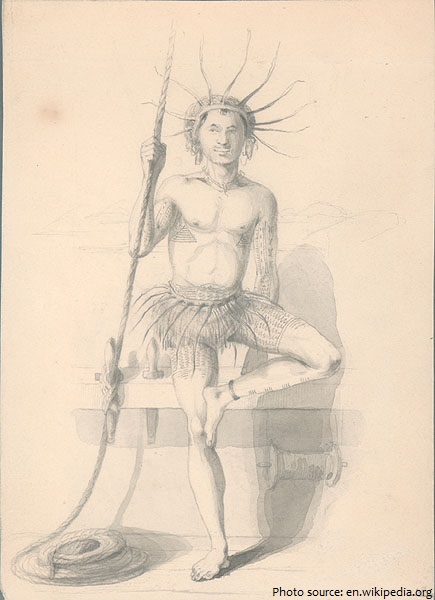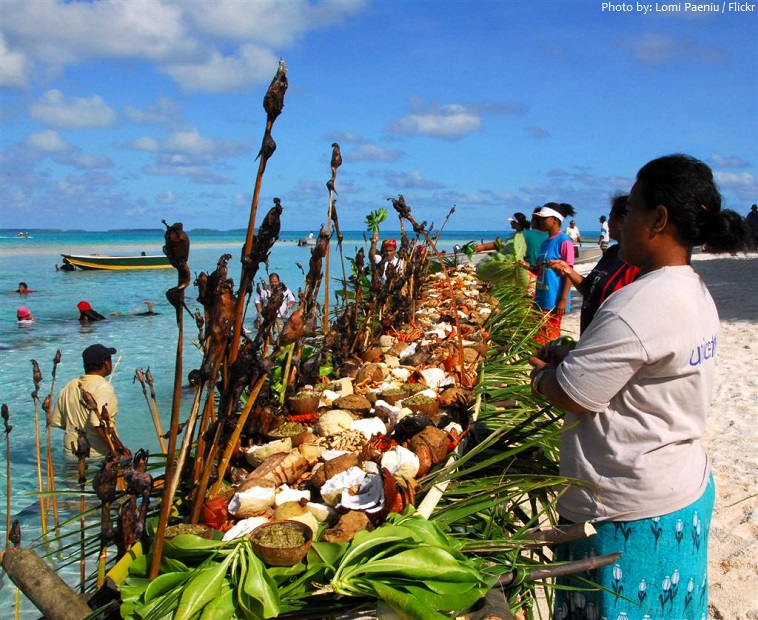Tuvalu is an island country located in the southern Pacific Ocean.
The official name of the country is Tuvalu.
Its closest neighbours are the Solomon Islands to the west-southwest, Nauru to the northwest, Kiribati to the north, Tokelau to the east, Samoa and Wallis and Futuna to the southeast, and Fiji to the south.
It is situated 4,000 kilometers (2,500 mi) northeast of Australia and is approximately halfway between Hawaii and Australia.
Tuvalu has two official languages: Tuvaluan and English.
As of 1 January 2017, the population of Tuvalu was estimated to be 10,045 people.
With an area of 26 square kilometers (10 square miles), Tuvalu is the fourth smallest country by area in the world, behind Vatican City, Monaco and Nauru.
Tuvalu is a volcanic archipelago and consists of three reef islands: Nanumanga, Niutao, Niulakita and six true atolls: Funafuti, Nanumea, Nui, Nukufetau, Nukulaelae and Vaitupu.
Funafuti is an atoll on which the capital of the island nation of Tuvalu is located. It is the most populated atoll with 56% of Tuvalu’s population. The capital of Tuvalu is sometimes given as Fongafale or Vaiaku, but the entire atoll of Funafuti is officially the capital.
The highest elevation is 4.6 meters (15 ft) above sea level on Niulakita, which gives Tuvalu the second-lowest maximum elevation of any country (after the Maldives).
The coastline of the islands total 24 kilometers (15 miles) in length.
With its picture-perfect beaches and turquoise waters it is surprising that the South Pacific paradise of Tuvalu is not popular with the masses.
The South Pacific paradise of Tuvalu is the least visited country in the world with just about 1,000 tourists per year.
In Tuvalu the climate is humid and hot with an annual temperature of 30 degrees Celsius (86° Fahrenheit) and it has little seasonal variation.
Tuvalu experiences two distinct seasons, a wet season from November to April and a dry season from May to October.
The origins of the people of Tuvalu are addressed in the theories regarding migration into the Pacific that began about 3000 years ago.
During pre-European-contact times there was frequent canoe voyaging between the nearer islands including Samoa and Tonga. Eight of the nine islands of Tuvalu were inhabited; thus the name, Tuvalu, means “eight standing together” in Tuvaluan.
Tuvalu was first sighted by Europeans on 16 January 1568 during the voyage of Álvaro de Mendaña de Neira from Spain who sailed past the island of Nui, and charted it as Isla de Jesús (Spanish for “Island of Jesus”) because the previous day was the feast of the Holy Name.
In 1819 the island of Funafuti was named Ellice’s Island; the name Ellice was applied to all nine islands after the work of English hydrographer Alexander George Findlay.
The islands came under Britain’s sphere of influence in the late 19th century, when each of the Ellice Islands was declared a British Protectorate by Captain Gibson of HMS Curacoa, between 9 and 16 October 1892.
The Ellice Islands were administered as British protectorate by a Resident Commissioner from 1892 to 1916 as part of the British Western Pacific Territories (BWPT), and then as part of the Gilbert and Ellice Islands Colony from 1916 to 1974.
In 1974, the Ellice Islanders voted for separate British dependency status as Tuvalu, separating fromthe Gilbert Islands which became Kiribati upon independence.
Tuvalu became fully independent within the Commonwealth on 1 October 1978.
On 5 September 2000, Tuvalu became the 189th member of the United Nations.
Tuvaluans are primarily involved in traditional agriculture and fishing.
One of Tuvalu’s largest sources of income is from the lease of its highly fortuitous .tv Internet Top Level Domain (TLD).
The most widely grown crops in Tuvalu are taro and coconut. In addition, copra (the dried flesh of a coconut used in making coconut oil) is a major part of Tuvalu’s economy.
The cuisine of Tuvalu is based on the staple of coconut and the many species of fish found in the ocean and lagoons of the atolls. Desserts made on the islands include coconut and coconut milk,
instead of animal milk. The traditional foods eaten in Tuvalu are pulaka, taro, bananas, breadfruit and coconut.
The island enjoys little crime and a low terror threat and doesn’t have armed forces.
Transport services in Tuvalu are limited. There are about 8 kilometers (5 miles) of roads.
Global warming is a concern in Tuvalu since the average height of the islands is less than 2 metres (6.6 feet) above sea level. Tuvalu could be one of the first nations to experience the effects of sea level rise.
As an island nation the number of native plants and animals in Tuvalu are severely limited. The native land life is almost non-existent and the native plant life was also very limited; only the migrating birds and sea life had any significant presence in historic Tuvalu. Most of what is found on the islands today was introduced in pre-historic times by the migrating people, birds, winds, and ocean currents.
As an island nation that rose from the sea floor there were no native mammals in Tuvalu, although a few bat species arrived thousands of years ago.
A traditional sport played in Tuvalu is kilikiti, which is similar to cricket.
A popular sport specific to Tuvalu is Ano, which is played with two round balls of 12 cm (5 in) diameter. Ano is a localised version of volleyball, in which the two hard balls made from pandanus
leaves are volleyed at great speed with the team members trying to stop the Ano hitting the ground.






